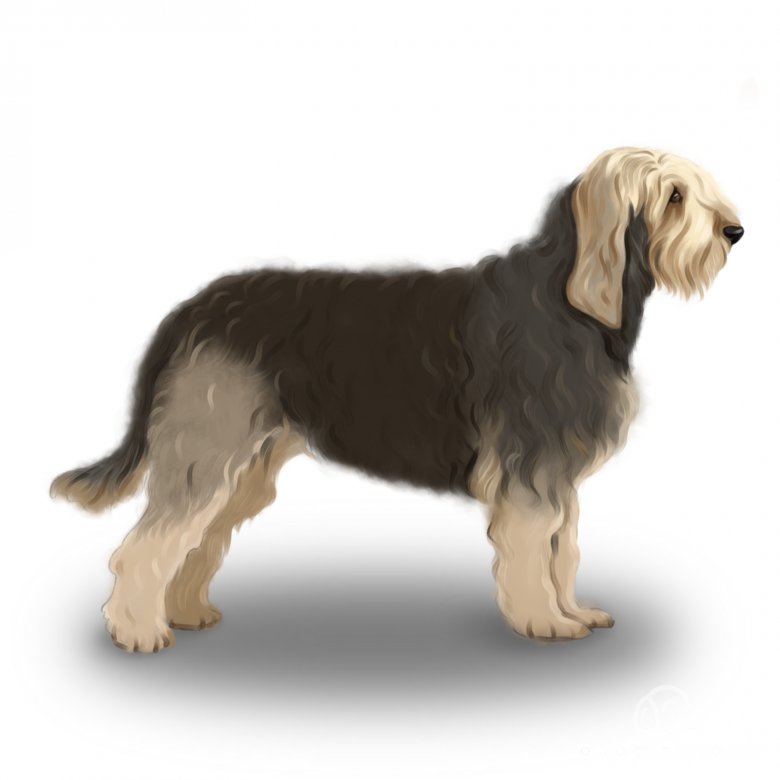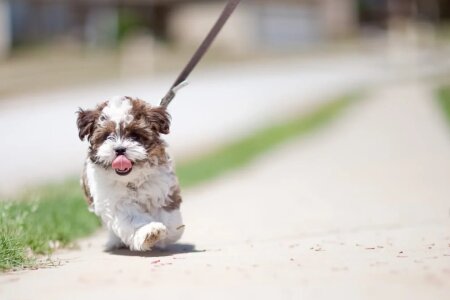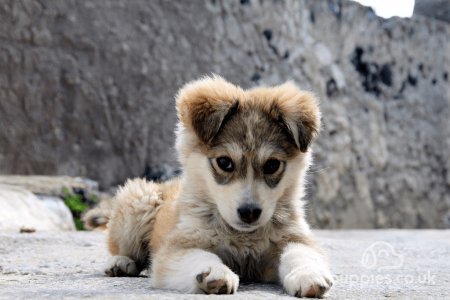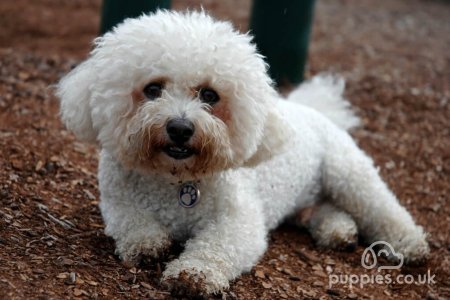Otterhound (Woolies)
Overview
The cute, fluffy Otterhound is an adorable hound breed from the North West of England that is currently extremely rare around the world. Underneath their large stature and rugged appearance, Otterhounds have a friendly, amiable, and even-tempered disposition that makes them loving companions for owners and their families.
Physical Appearance
Otterhounds are a large-sized breed that stands evenly, straight and sound in their neutral stance. They exude strength and have a muscular frame, but their distinctively fluffy double coat makes them easily distinguishable.
Their eyes demonstrate intelligence and are deeply set, with colouring around the rims matching or complementing their coat colour. Their ears are unique and a distinguishing feature. They are set long and in a pendulous fashion with a characteristic fold. Their tails taper from thick at the base to thin outwards and are carried straight up with little curvature when alert.
Coat colours vary widely, including whole white coloured, grizzle, red, sandy, wheaten, and blue. Many markings, spots, and colour variations and combinations exist which are permissible.
Otterhounds somewhat resemble Griffon Nivernais and Griffon Vendeen breeds, to which they are related.
How big do Otterhound dogs get?
Character Traits
Jovial, amiable, and even-tempered, Otterhounds love to please their owners just as much as they love to be pleased themselves. Aggression is a highly undesirable trait, so most ethically bred Otterhounds will not show signs of aggression at all, making them a safe and ideal companion pet for owners with families, including around young children.
They do tend to have their own unique sense of independence, which can prove frustrating for owners. Otterhounds will happily play with other pets, owners, and their families for long bouts of joyful play sessions, but when they’ve had enough and want to do their own thing, it will be obvious.
On account of these traits, they are wonderful companion pets but make for poor watchdogs or guard dogs.
Are Otterhound dogs intelligent? Yes.
Are Otterhound dogs affectionate? Yes, very.
Do Otterhound dogs have high or low energy levels? High energy.
Are Otterhound dogs loyal? Yes.
Are Otterhound dogs playful? Yes, very.
Are Otterhound dogs aggressive? No.
Are Otterhound dogs easy to train? Yes.
Are Otterhound dogs good guard dogs? No, they are too friendly to be watchdogs or guard dogs.
Ability to Socialise
It is fairly easy to socialise an Otterhound thanks to their even-tempered disposition and their amiable behaviour. When well-raised and well-socialised, Otterhounds tend to get along just fine with other dogs, small pets such as cats, and other people, including strangers.
On the other hand, their superior intelligence can also lead to developing naughty habits and behaviour if neglected. Although hardly ever aggressive, Otterhounds may bark, pout, or chew on furniture if their personal emotional needs are unmet.
Keep in mind that around watercourses, Otterhounds will pick up a scent easily and thereby engage their prey drive. Walk your Otterhound on a lead in public and allow him to roam off-lead when safe to do so, but keep him well supervised around watercourses or where small animals are running around.
Do Otterhound dogs get along with other pets? Yes.
Do Otterhound dogs get along with other dogs? Yes.
Are Otterhound dogs good with kids? Yes.
Are Otterhound dogs good with strangers? Yes, they are very sociable around strangers.
Lifestyle Suitability
Otterhounds thrive in homes where there is ample outdoor space to roam around and play, both activities they love to partake in. Consequently, they are not ideal at all for apartment dwelling or in tight urban areas where they will likely feel timid and constrained.
It is far better to adopt or purchase an Otterhome in a home with a large garden, particularly if fenced in, whereby the Otterhound can work off much of his high energy.
As a hound dog bred for otter hunting near low brush and shallow watercourses, Otterhounds are well accustomed to cool temperatures. This is also a reason why they have a rather high prey drive and are prone to chasing.
First-time puppy owners may have some difficulties raising an Otterhound, not only because it is incredibly difficult to find one but also because their strong independent streak can be difficult to manage well unless the owner is experienced with raising puppies.
Are Otterhound dogs good for first-time owners? No.
Are Otterhound dogs hypoallergenic? No.
Are Otterhound dogs prone to drooling? No.
Are Otterhound dogs a good breed for apartment living? Absolutely not.
Do Otterhound dogs shed a lot? A moderate amount of shedding.
Do Otterhound dogs bark a lot? No, not much.
Can Otterhound dogs be left alone at home? Yes, for moderate lengths of time.
Can Otterhound dogs handle the heat? Yes, but not too hot.
Can Otterhound dogs handle cold temperatures? Yes.
Are Otterhound dogs sensitive to loud noises? Yes.
General Health & Health Issues
Otterhounds have a slightly below average ranking in terms of health when compared to other breeds. Unfortunately, many Otterhounds are prone to bone and joint problems in particular, which can range in severity from pain and discomfort to lameness.
In terms of hereditary diseases and conditions, Otterhounds do not suffer from as many as with other breeds, perhaps due to their small gene pool and low numbers from which insufficient data is available.
Even if your Otterhound appears to be perfectly health, ensure that he is taken to see the veterinarian every so often to diagnose any potential health problems.
Some common problems include:
Bloat: common to many breeds, bloat and sometimes gastric torsion can result from poor feeding habits or overeating, especially as Otterhounds grow into adulthood;
Epilepsy: epileptic seizures are somewhat common amongst Otterhounds, and can prove worrisome and debilitating. It is best to have your Otterhound regularly tested and treated for epilepsy;
Hip dysplasia: common to many large breeds, including Otterhounds, hip dysplasia is the abnormal growth of the hip bones, which can be hereditary and lead to pain and discomfort to the lameness of one or more legs;
Elbow dysplasia: along with hip dysplasia, another bone and joint health problem that Otterhounds are prone to is elbow dysplasia. If your Otterhound has difficulty standing or walking properly (i.e. with a limp) have him brought in for testing.
How long do Otterhound dogs live? - 10-13 years
Exercise & Play Time
As an active, outdoor breed, Otterhounds love playing outdoors and require plenty of exercise to match their high energy levels. Anywhere from one hour to an hour and a half every day will be necessary to keep him stimulated both physically and mentally.
Although it is generally safe to take your Otterhand off the lead in safe spaces, keep a close eye on him since he may chase small animals quite far away. This is part of the Otterhound’s natural instinct, and rather than punish them for behaving naturally, engage them with activities that simulate chasing such as throwing a stick or ball.
One particularity of Otterhounds is their adaptation from hunting hounds in low-lying brush and watercourses, which means they’ll naturally love to splash around and swim in the water whilst chasing around ducks or waterfowl.
How much exercise does an Otterhound dog need? - At least 1 hour per day
Do Otterhound dogs like water play? Yes, they are naturally great swimmers.
Nutrition & Feeding
Otterhounds eat quite a bit, especially in their formative months as puppies. It’s important that owners feed them according to a strict regimen, broken into three to four meals daily.
Feed your Otterhound a rich diet full of healthy proteins, minerals, and vitamins and consider alternative diets such as raw food or cold-pressed rather than hot extrusion dog food (i.e. kibble), but always consult with your veterinarian first to see if it is appropriate for your specific dog.
Note that Otterhounds tend to make a bit of a mess whilst eating. Cleaning their beards frequently is therefore necessary.
Are Otterhound dogs prone to weight gain? Yes, especially as they age.
How much should I feed an Otterhound puppy? About 270-610g per day, in 3-4 sessions.
How much should I feed an adult Otterhound dog? About 340-550g per day, in total.
Care & Maintenance
Despite having a thick coat that may seem difficult to groom, they aren’t exactly the most high-maintenance breed and are instead fairly easy to care for. Their moderate amount of shedding, however, may require more frequent vacuum cleaning around the home.
Emotionally, Otterhounds are not too demanding and can be left alone for moderate lengths of time. Just don’t make this a habit or else they can become bored and possibly destructive.
- Grooming: once a week, brush your Otterhound’s coat of fur and remove any dead hairs, and pay special attention to any twigs, dirt, or soil that can easily get caught in their thick coats. Have their ears and eyes inspected and cleaned out every week to avoid infections.
- Emotional care: Otterhounds can tolerate some separation anxiety, perhaps a few hours during the day. Do not let this become an everyday occurrence.
History of the Otterhound
It remains unknown exactly where the Otterhound draws its origins, but the earliest recorded Otterhound breeds date to the early 19th century. Other breeds, most likely French breeds from Normandy, were crossed in the following decades until the early 20th century when the Griffon Nivernais was crossed and the current breed of Otterhound remained until this day.
Otter hunting was banned in the UK in 1978, which led to a great decline in the need for Otterhounds. Nevertheless, breeders persistently continued to breed these beautiful dogs and their numbers have stabilised in recent years. They remain relatively unpopular, however.
Interesting Facts About Otterhound Dogs
The Kennel Club has declared Otterhounds to be a Vulnerable Native Breed. Only 600 exist worldwide;
All Otterhounds can be traced back to one common ancestor, a crossbreed of Grand Griffon Vendéen and Bloodhound, named Boatman;
The Otterhound is the most endangered dog breed in all of Britain. Efforts are being made to save this breed.
Getting an Otterhound Puppy
It may be difficult to find an Otterhound puppy, simply because their population worldwide is extremely low. Before purchasing any puppy, we recommend that prospective owners consult our extensive buying guide. If you believe that you’d like to purchase an Otterhound and you understand your responsibilities as a proud owner of a loving Otterhound, our breeders are reputable.
How much does an Otterhound cost to buy? - Over £700.
How much does an Otterhound cost to feed? - An adult Otterhound costs about £1.00-£1.40 per day to feed.
How much does insurance for an Otterhound cost? - About £30-£70 per month.
Sensible alternatives to purchasing a new Otterhound puppy include rescue and adoption.
Additional resources can be found via Otterhound registries and associations such as:











